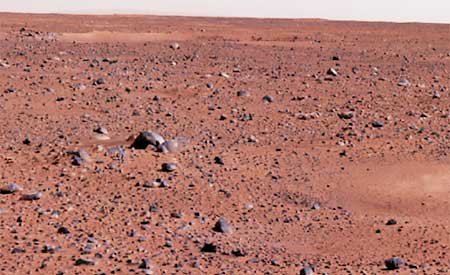Red Rover, Red Rover

Say cheese. This is the first color image of Mars taken by the panoramic camera on the Mars Exploration Rover Spirit. It is the highest resolution image ever taken on the surface of another planet. Image Credit: NASA / JPL / Cornell
In Search for Life on Mars, Machines Can Boldly Go Where Humans Can’t
By Lawrence M. Krauss
(This article first appeared on January 6, 2004, in the New York Times.)
With dwindling hope, scientists with the European Space Agency have awaited a nine-note musical message, much like the sound I hear on my daughter's cellphone when it receives a call.
Hearing this tune, written by a British band, Blur, would signal that the British-built Beagle 2 spacecraft landed safely on Mars two weeks ago and could begin experiments to detect trace signatures of past or present microbial life.
Whether or not the tiny Beagle 2 survived its dangerous descent to the Martian surface, the Spirit, a robotic craft launched by NASA, landed safely on the planet over the weekend and began transmitting photographs of the surface within hours. A sister NASA rover, the Opportunity, will try to land this month.
The rovers are to travel several hundred feet a day in search of evidence that liquid water once flowed on Mars.
Humanity has been fascinated by the possibility that life may have existed on Mars, our closest planetary neighbor, for as long as telescopes have allowed us to peer at its red surface. At the end of the 19th century, the American astronomer Percival Lowell detected what he was certain were "canals" on Mars that reflected an advanced industrial society.
While we now know that this was merely an optical illusion because of the limited resolution of the available observation instruments, Lowell's statements prompted generations of books and movies speculating on Martian invasions of Earth.
The fascination with the possibility that life once existed on Mars is not restricted to literature and the movies.
Scientists recognize that the climate of the barren planet was once quite different, with a denser, warmer atmosphere, as well as the possibility that liquid water may have flowed on its surface. Seven years ago, analysis of a Martian meteorite found in Antarctica set scientists abuzz with the claimed discovery of fossilized evidence of microscopic life forms.
Although most scientists now view that evidence as suspect, the idea that some ancient life may have existed on Mars remains plausible. Indeed, given that the Martian rock being analyzed was found on Earth makes it clear that material is regularly exchanged between the planets. For all we know, life on one planet may have "seeded" life on another at some time.
In spite of the tantalizing idea that life might be found on Mars, mounting a successful mission there to resolve this mystery is not so easy. Of the 11 attempted landings on Mars, only 4 have been successful up to now.
Space travel remains a difficult and expensive activity. But the excitement surrounding the current European and American landings makes it clear that the scientific questions that they may answer inspire a host of people. The activity also makes clear a fact that most scientists keep trying to underscore, that the best, most exciting and cheapest science involves unmanned spacecraft.
Even after only a 35 percent success rate thus far, the 11 missions to Mars have in total cost probably less than 1 percent of the projected cost of sending astronauts to Mars. Moreover, a lost robotic spacecraft is replaceable. An astronaut isn't.
As President Bush and NASA try to re-examine how to revitalize America's manned-space program, now is the time to face up to various truths about human space travel from scientific and human perspectives.
First, basically all that we learn from sending humans into space is how humans can survive in space. The International Space Station, orbiting several hundred miles above Earth, is not only boring, but it is also expensive.
Pretending that it has a scientific objective of any significance is an insult to those aspects of NASA, including the Great Observatory programs, and the new rover landings, that promise real science.
If we are going to send human beings into space, we must recognize that we are doing it primarily for adventure and to fulfill a human yearning to directly explore where "no one has gone before."
There is nothing wrong with adventure. At the very least, in inspires young people to think about the cosmos, much as the Apollo missions fascinated and excited my own interest in science 30 years ago. But to keep our space program vibrant, we need to ensure that we supplement expensive human space missions with important, and cheaper, scientific ones like the three current Mars missions.
Perhaps one day humans will visit, and even colonize, Mars. Perhaps this is our destiny. But for now, two — and maybe three — small robotic messengers are poised to help answer one of the most profound questions in science. Is there life, even primitive life, elsewhere in the universe?
I am rooting for one of the tiny spacecraft now lying alone on the inhospitable Martian soil, hopefully sending out messages to Earth, almost 100 million miles away, and I will not be disappointed if the first encounter with evidence of life elsewhere is made by a machine.
Lawrence M. Krauss, chairman of the physics department at Case Western Reserve University, recently testified before Congress on the future of space exploration.











